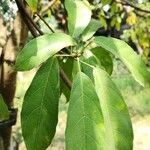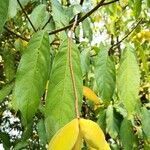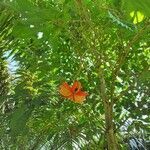Trees; bark brown-black. Branchlets at first minutely stellate. Leaves simple; stipules caducous; petiole 2-3.5 cm; leaf blade oblong or elliptic, 8-25 × 5-15 cm, thinly leathery, glabrous, base rounded or obtuse, apex acute or obtuse. Inflorescence terminal or axillary, paniculate, slender and lax, to 20 cm, pubescent. Pedicels much longer than flowers. Calyx cream-white, becoming reddish, campanulate, ca. 10 mm, abaxially pubescent, lobes linear-lanceolate, as long as calyx tube, apex acuminate, incurved and cohering apically, as long as calyx tube. Male flowers many, androgynophore curved, glabrous, anthers yellow. Female flowers fewer, slightly larger. Ovary globose, with 5 grooves, densely hairy; style curved; stigma shallowly 5-lobed. Follicles red, oblong-ovate, ca. 5 × 2-3 cm, 1-4-seeded, thickly leathery, apex beaked. Seeds black-brown, ellipsoid or oblong, ca. 1.5 cm. Fl. Apr-May, rarely Oct-Nov.
More
A small tree. It is in the same family as cocoa. The tree is always green. It grows to 10-30 m tall. The main stem is short but with many branches. The young branches are hairy. The leaves are at the tips of the shoots. The leaves are large and leathery. They are 12.5-22.5 cm long by 7.5-12.5 cm wide. Both male and female flowers occur on the same tree. The flowers are pinkish and about 1.2 cm across. They are in drooping panicles. The flowers occur at the ends of branches. The fruit are pods that change from green to red as they ripen. There are usually 3-5 pods in a group. The pods are covered with fine soft hairs. The pods are 7.5-10 cm long and 5 cm wide. The pods split open showing the seeds. There are 1-3 seeds. The seeds are 2.5-5 cm long and 1.2-2.5 cm wide. The seeds are black, shiny and sticky.





